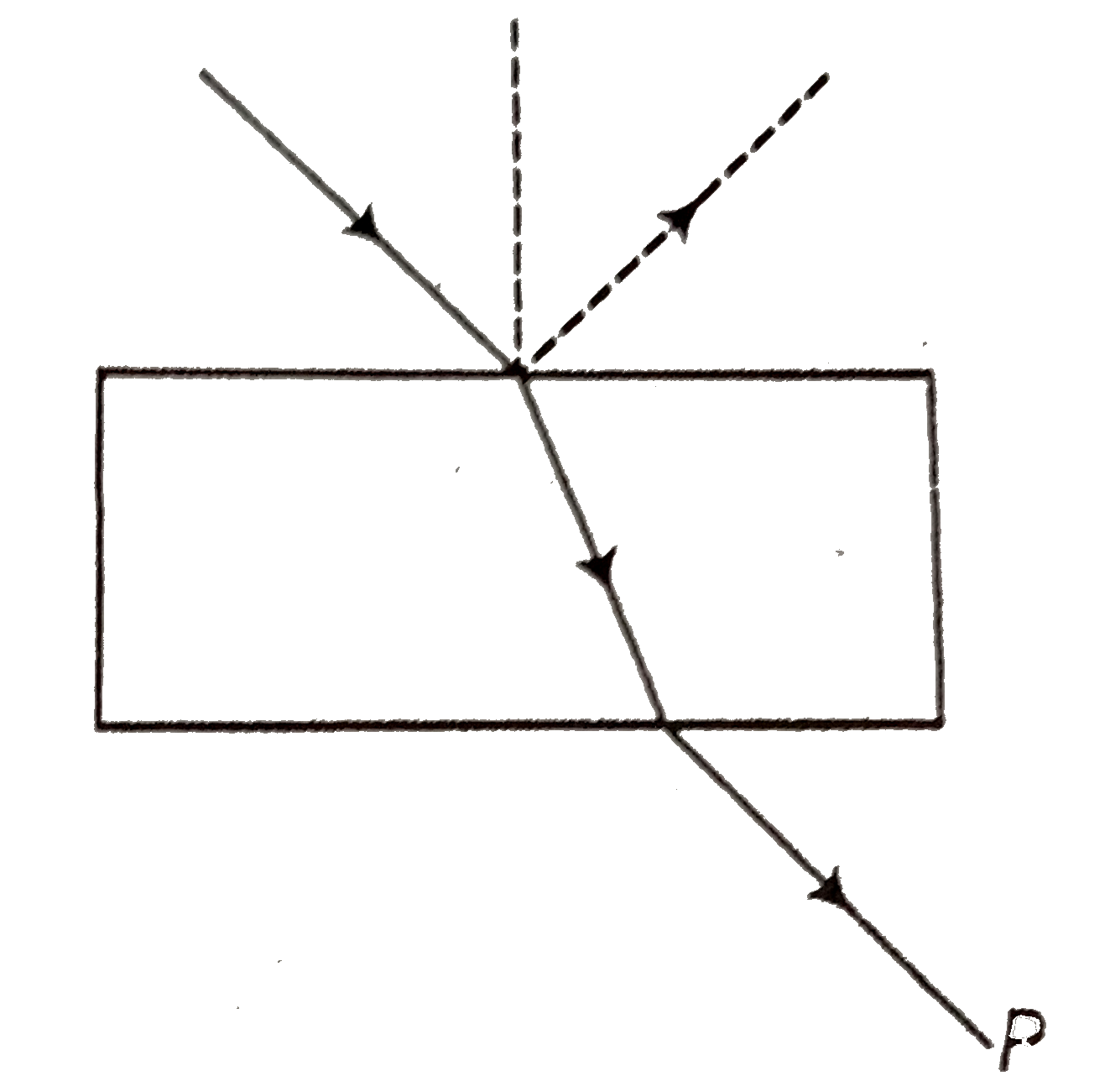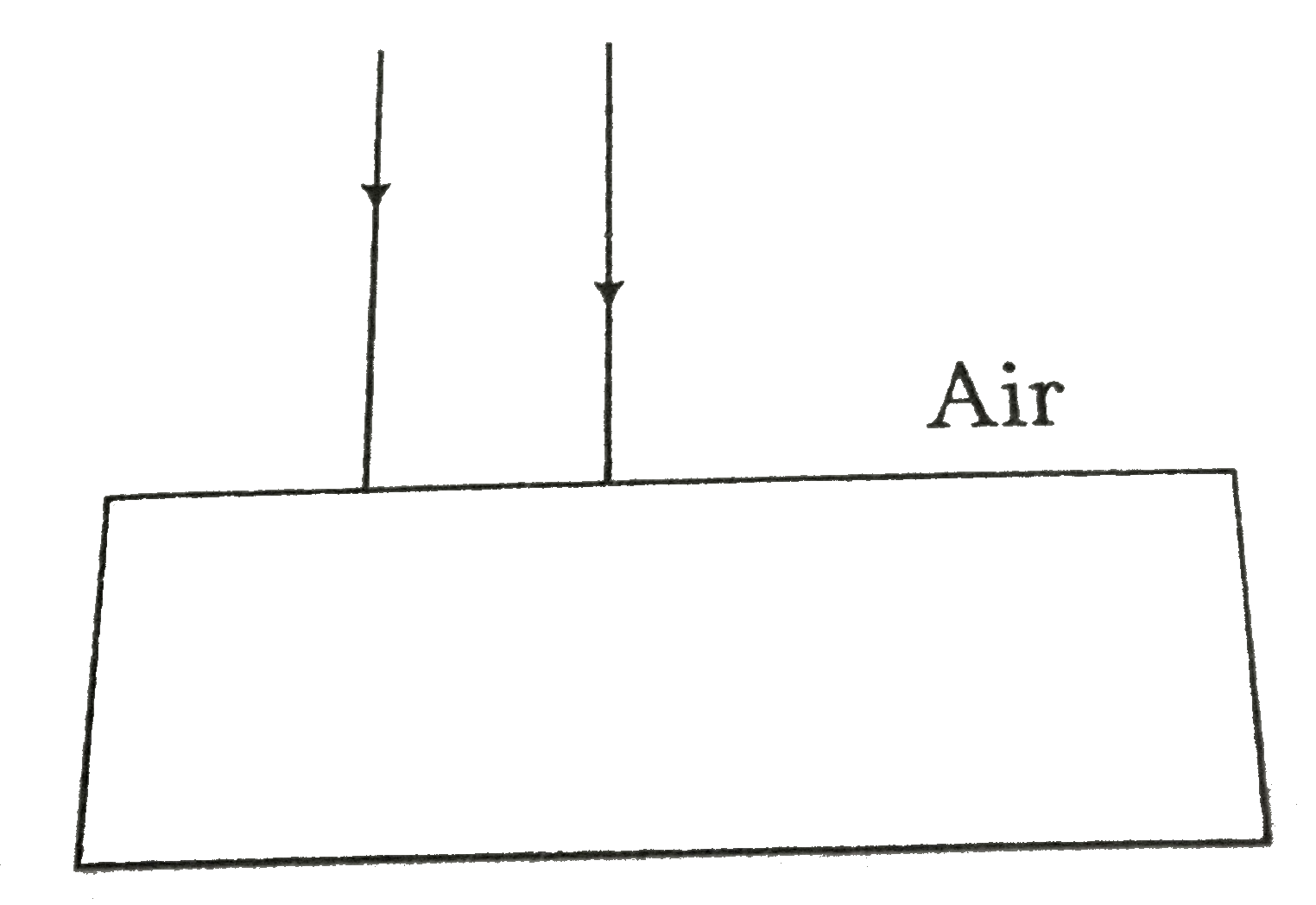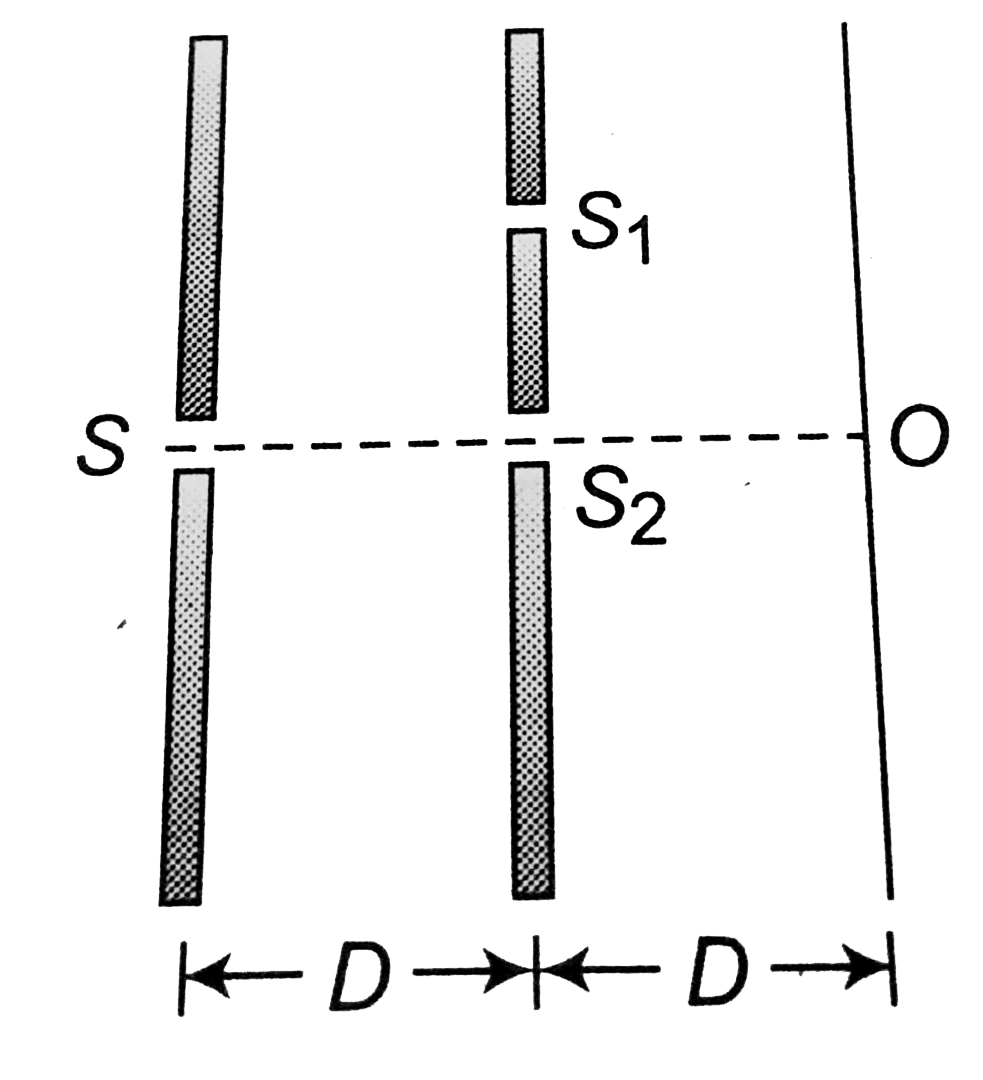Complete Solutions to taking it together of chapter WAVE OPTICS of Class 12 book with complete answers and questions
| Class 12 | PHYSICS |
| Chapter | WAVE OPTICS |
| DC PANDEY NEET | taking it together |
| Number Of Questions | 47 |
| Academic Year | 2023-24 |
In a Young's double slit experiment, the source is white light. One of the holes is covered by a red filter and another by a blue filter. In this case
View SolutionIn a Young's double-slit experment, the fringe width is `beta`. If the entire arrangement is now placed inside a liquid of refractive index `mu`, the fringe width will become
View SolutionConsider sunlight incident on a slit of width `10^(4) Å` . The image seen through the slit shall
View SolutionIn Young's double-slit experiment the angular width of a fringe formed on a distant screen is `1^(@)`. The wavelength of light used is `6000 Å`. What is the spacing between the slits?
View SolutionConsider a light beam incident from air to a glass slab at Brewster's angle as shown in figure.
A polaroid is placed in the path of the emergent ray at point P and rotated about an axis passing through the centre and pependicular to the plane of the plaroid.

View SolutionTwo waves of same frequency and same amplitude from two monochromatic sources are allowed to superpose at a certain point. If in one case the phase difference is 0 and in other case it is `pi//2` then the ratio of the intensities in the two cases will be
View SolutionWhat is the minimum thickness of a soap bubble needed for constructive interference in reflected light, if the light incident on the film is 750 nm? Assume that the refractive index for the film is `n=1.33`
View SolutionMonochromatic light from a narrow slit illuminates two parallel slits producing an interference pattern on a screen. The separation between the two slits is now doubled and the distance between the screen and the slits is reduced to half. The fringe width
View SolutionLights of wavelengths `lambda_(1)=4500 Å, lambda_(2)=6000 Å` are sent through a double slit arrangement simultaneously. Then
View SolutionEstimate how large can be the aperture opening to work with laws of ray optics using a monochromatic light of wavelength 450 nm, to a distance of around 20 m.
View SolutionTwo slits at a distance of `1mm` are illuminated by a light of wavelength `6.5xx10^-7m`. The interference fringes are observed on a screen placed at a distance of `1m`. The distance between third dark fringe and fifth bright fringe will be
View SolutionIn a Young's double slit experiment, 12 fringes are observed to be formed in a certain segment of the screen when light of wavelength `600nm` is used. If the wavelength of light is changed to `400nm`, number of fringes observed in the same segment of the screen is given by
View SolutionA parallel beam of monochromatic light of wavelength `5000Å` is incident normally on a single narrow slit of width `0.001mm`. The light is focused by a convex lens on a screen placed on the focal plane. The first minimum will be formed for the angle of diffraction equal to
View SolutionIn Young's double slit experiment, the 10th maximum of wavelength `lambda_(1)` is at distance of `y_(1)` from the central maximum. When the wavelength of the source is changed to `lambda_(2)` , 5th maximum is at a distance of `y_(2)` from its central masximum. Then `(y_(1))/(y_(2))` is
View SolutionIt is found that what waves of same intensity from two coherent sources superpose at a certain point, then the resultant intensity is equal to the intensity of one wave only. This means that the phase difference between the two waves at that point is
View SolutionThe two slits are 1 mm apart from each other and illuminated with a light of wavelength `5xx10^(-7)` m. If the distance of the screen is 1 m from the slits, then the distance between third dark fringe and fifth bright fringe is
View SolutionWhat is the minimum thickness of a soap bubble needed for constructive interference in reflected light, if the light incident on the film is 750 nm? Assume that the refractive index for the film is `n=1.33`
View SolutionA thin mica sheet of thickness `4xx10^(-6)` m and refractive index `(mu=1.5)` is introduced in the path of the light from upper slit. The wavelength of the wave used is `5000 Å` The central bright maximum will shift
View SolutionLight of wavelength `589.3nm` is incident normally on the slit of width `0.1mm`. What will be the angular width of the central diffraction maximum at a distance of `1m` from the slit?
View SolutionYoung's double slit experiment is made in a liquid. The tenth bright fringe in liquid lies in screen where 6th dark fringe lies in vacuum. The refractive index of the liquid is approximately
View SolutionTwo beams of ligth having intensities I and 4I interface to produce a fringe pattern on a screen. The phase difference between the beams is `(pi)/(2)` at point A and `pi` at point B. Then the difference between the resultant intensities at A and B is
View SolutionIn a Young's double slit experiment using red and blue lights of wavelengths 600 nm and 480 nm respectively, the value of n for which the nth red fringe coincides with `(n+1)` th blue fringe is
View SolutionTwo beams of ligth having intensities I and 4I interface to produce a fringe pattern on a screen. The phase difference between the beams is `(pi)/(2)` at point A and `pi` at point B. Then the difference between the resultant intensities at A and B is
View SolutionIn Young's double slit experiment how many maxima can be obtained on a screen (including the central maximum) on both sides of the central fringe if `lambda=2000Å` and `d=7000Å`
View SolutionA beam of light parallel to central line AB is incident on the plane of slits. The number of minima obtained on the large screen is `n_1`. Now if the beam is tilted by some angle `(!= 90^@)` as shown in figure, then the number of minima obtained is `n_2`. Then,
View SolutionUnpolarized light of intensity 32 `Wm^(-3)` passes through three polarizers such that the transmission axis of the last polarizer is crossed with the first. If the intensity of the emerging light is `3 Wm^(-2)`, what is the angle between the transmission axces of the first two polarizers ? At what angle will the transmitted intensity be maximum ?
View SolutionIn a Young's experiment, one of the slits is covered with a transparent sheet of thickness `3.6xx10^(-3)cm` due to which position of central fringe shifts to a position originally occupied by 30th fringe. If `lambda=6000 Å`, then find the refractive index of the sheet.
View SolutionIn Young's double slit experiment the y-coordinates of central maxima and 10th maxima are `2cm` and `5cm` respectively. When the YDSE apparatus is immersed in a liquid of refractive index `1.5` the corresponding y-coordintates will be
View SolutionIn Young's double slit experiment, wavelength `lambda=5000Å` the distance between, the slits is `0.2mm` and the screen is at 200cm from the slits. The central maximum is at `x=0` The third maximum (Taking the central maximum as zeroth maximum) will be at x equal to
View SolutionA parallel beam of light of intensity I is incident on a glass plate. `25%` of light is reflected in any reflection by upper surface and `50%` of light is reflected by any reflection from lower surface. Rest is refracted The ratio of maximum to minimum intensity in interference region of reflected rays is

View SolutionIn the Young's double slit experiment, the intensities at two points `P_(1)` and `P_(2)` on the screen are respectively `I_(1)` and `I_(2)` If `P_(1)` is located at the centre of a bright fringe and `P_(2)` is located at a distance equal to a quarter of fringe width from `P_(1)` then `I_(1)/I_(2)` is
View SolutionA monochromatic beam of light fall on YDSE apparatus at some angle (say `theta`) as shown in figure. A thin sheet of glass is inserted in front of the lower slit `s_(2)`. The central bright fringe (path difference `= 0`) will be obtained

View SolutionFigure shows a standard two slit arrangement with slits `S_(1), S_(2). P_(1), P_(2)` are the two minima points on either side of P (Figure). At `P_(2)` on the screen, there is a hole and behind `P_(2)` is a second 2-slit arrangement with slits `S_(3), S_(4)` and a second screen behind them.

View SolutionIn Young's double slit experiment, the two slits acts as coherent sources of equal amplitude A and wavelength `lambda`. In another experiment with the same set up the two slits are of equal amplitude A and wavelength `lambda` but are incoherent. The ratio of the intensity of light at the mid-point of the screen in the first case to that in the second case is
View SolutionIn the ideal double-slit experiment, when a glass-plate (refractive index 1.5) of thickness t is introduced in the path of one of the interfering beams (wavelength `lambda`), the intensity at the position where the central maximum occurred previously remains unchanged. The minimum thickness of the glass-plate is
View SolutionIn the standard Young's double slit experiment, the intensity on the screen at a point distant `1.25` fringe widths from the central maximum is (assuming slits to be identical)
View SolutionIn a Young's double slit experiment, D equals the distance of screen and d is the separation between the slits. The distance of the nearest point to the central maximum where the intensity is same as that due to a single slit is equla to
View SolutionWhite light is used to illuminate the two slits in a Young's double slit experiment. The separation between the slits is b and theh screen is at a distance `d (gt gtb)` from the slits At a point on the screen directly in front of one of the slits, certain wavelengths are missing some of these missing wavelengths are
View SolutionThe intensity of each of the two slits in Young's double slit experiment is `I_(0)` Calculate the minimum separation between the two points on the screen where intensities are `2I_(0)` and `I_(0)` Given the fringe width equal to `alpha`
View SolutionIn a double-slit experiment, fringes are produced using light of wavelength `4800A^(@)`. One slit is covered by a thin plate of glass of refractive index 1.4 and the other slit by another plate of glass of double thickness and of refractive index 1.7. On doing so, the central bright fringe shifts to a position originally occupied by the fifth bright fringe from the centre. find the thickness of the glass plates.
View SolutionAn interference is observed due to two coherent sources separated by a distance `5lambda` along Y-axis, where `lambda` is the wavelength of light A detector D is moved along the positive X -axis The number of point on the X-axis excluding the points x=0 and `x=infty` at which resultant intensity will be maximum are
View SolutionIn a Young's double slit experiment, using unequal slit widths, the intensity at a point midway between a bright and dark fringes is 4I. If one slit is covered by an opaque film, intensity at that point becomes 2I. If the other is covered instead, then the intensity at that point is
View SolutionTwo coherent light sources A and B are at a distance `3lambda` from each other `(lambda`=wavelength)The distances from A on the X-axis at which the interference is constructive are

View SolutionTwo coherent sources separated by distance d are radiating in phase having wavelength `lambda`. A detector moves in a big circle around the two sources in the plane of the two sources. The angular position of `n=4` interference maxima is given as

View SolutionConsider a ray of light incident from air onto a slab of glass (refractive index n) of width d, at an angle `theta` . The phase difference between the ray reflected by the top surface of the glass and the bottom surface is
View SolutionTwo ideal slits `S_(1)` and `S_(2)` are at a distance `d` apart, and illuninated by light of wavelength `lambda` passing through an ideal source slit `S` placed on the line through `S_(2)` as shown. The distance between the planes of slits and the source slit is `D.A` screen is held at a distance `D` from the plane of the slits. The minimum value of `d` for which there is darkness at `O` is `(dlt lt D)`

View SolutionIn the adjacent diagram, CP represents a wavefront and AO & BP, the corresponding two rays. Find the condition on `theta` for constructive interference at P between the ray BP and reflected ray OP.

View Solution
taking it together questions and complete solutions for chapter WAVE OPTICS of DC PANDEY PHYSICS (HINGLISH) of Class 12
All Exercises from DC PANDEY NEET Class 12 PHYSICS WAVE OPTICS
- Assertion reason
- Check point
- Example
- For JEE Advanced B. More than one option is correct
- For JEE Advanced C. Comprehension Type Questions. Passage (I)
- For JEE Advanced C. Comprehension Type Questions. Passage (II)
- For JEE Advanced C. Comprehension Type Questions. Passage (III)
- For JEE Advanced D. Matrix Matching type Questions.
- For JEE Advanced E. Integer Type Questions
- For JEE Advanced Only one option is correct
- For JEE main (Only one option is Correct )
- match column
- medical entrances
- taking it together